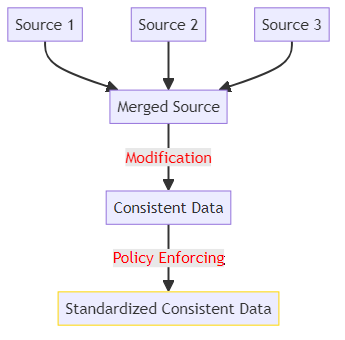
Data Management Solutions: Top Trends & Solutions

Data management solutions provide a comprehensive approach to collecting, organizing, securing, and leveraging a company’s data assets. These solutions help break down data silos. They also improve data quality. Additionally, they make it easier to access data throughout the entire company.
By unifying data from disparate sources into a centralized platform, data management solutions empower businesses to make informed decisions. Modern data management systems often incorporate artificial intelligence (AI) capabilities to help tackle complex data challenges.
The Importance of Data Management
In the modern business world, data has become a vital corporate asset. When businesses manage data well, it can provide useful information that helps improve marketing, lower costs, and increase revenue. However, without effective data management practices in place, data can quickly become a liability rather than an asset.
Inconsistent and siloed data hinders a company’s ability to derive meaningful insights through business intelligence and analytics initiatives. Poor data quality can lead to inaccurate findings.
Data is constantly increasing. Organizations may end up with “data swamps” – huge amounts of disorganized data that are difficult to manage and protect. These data swamps pose risks to organizations as they are hard to utilize, control, and secure.
Data management is important for following strict data privacy laws like GDPR. It helps companies comply with regulations and protect sensitive information.
Key Components of Data Management Solutions
Database Management Systems (DBMS)
At the core of any data management solution is a database management system (DBMS). A DBMS provides the tools and interfaces necessary to create, secure, update, and retrieve data stored within databases. It acts as a middle ground between the database itself and the applications or end-users that interact with it.
A well-designed DBMS ensures data consistency, integrity, and accessibility. It typically consists of three main components:
- The DBMS software itself, which enables users to manage the database
- The database engine, which is responsible for processing data access, locking, and editing requests
- The database schema, which defines the logical structure and organization of the data
Database management systems have tools to help with tasks like managing changes, backing up data, improving performance, and auditing. Designers created these tools to make it easier for users to handle various aspects of database management.
Managing changes, backing up data, improving performance, and auditing are all important tasks in maintaining a database. DBMSs provide tools to streamline these processes and make them more efficient.
Example: A retail company implements a DBMS to store and manage customer information, product catalogs, and sales transactions. The DBMS ensures data consistency across various applications, such as the company’s e-commerce website, inventory management system, and customer relationship management (CRM) software.
Master Data Management (MDM)
Master data management (MDM) aims to create a unified and reliable view of a company’s main business entities. These entities include customers, products, and suppliers. The discipline focuses on ensuring that the data is accurate and consistent across the organization. By unifying and harmonizing data from multiple sources, MDM ensures data accuracy, consistency, and reliability across the enterprise.
MDM processes establish and enforce data governance policies to maintain data quality and facilitate seamless data sharing between systems. This is particularly important in complex IT environments with numerous applications and platforms.

Example: A global manufacturing company adopts an MDM solution to create a unified view of its supplier data. The company can improve its procurement processes by collecting supplier information from various ERP systems and databases. This can help cut costs and lower supply chain risks.
Data Modeling
Data modeling is the process of creating visual representations of a company’s data structures and relationships. Using symbols and text, data models provide a blueprint for designing databases and aligning data assets with business requirements.
Good data modeling helps teams understand data needs, find problems early, and use data efficiently. Data models help developers write better code by giving a clear overview of the data they are using.
Example: A healthcare provider engages in data modeling to design a new electronic health record (EHR) system. The data model visually represents patient data, medical history, and treatment information, helping developers create a robust and efficient database structure.
Data Warehouses and Data Lakes
Data warehouses and data lakes are two common types of data repositories used in data management solutions. A data warehouse is a centralized repository that aggregates data from various systems for reporting and analysis purposes. Data warehouses typically store structured data in a hierarchical format, optimized for fast querying and business intelligence applications.
Data lakes, on the other hand, store large volumes of raw, unstructured data in its native format until it is needed for analysis. They are great for storing and processing large amounts of data, especially for machine learning tasks.
For example, a bank creates a data warehouse. The purpose is to merge data from various systems. These systems include credit card processing and loan origination. The data warehouse enables the institution to generate comprehensive reports and perform complex analytics to identify cross-selling opportunities and manage risk.
Product Information Management
PIM solutions help organizations store all product data in one central location. You can easily share this data across various channels such as websites, apps, and catalogs. PIM tools ensure product information accuracy, consistency, and completeness, improving the overall customer experience.
Product managers and marketing teams use PIM solutions to collect and enhance product data from different sources. They also use these solutions to fix any data inconsistencies. Additionally, they use PIM solutions to share up-to-date product information with sales and distribution channels.
Example: A fashion retailer implements a PIM solution to manage its extensive product catalog. The PIM system assists retailers in collecting product data from suppliers. It also allows them to include marketing content. Retailers can then share accurate product information on their website, app, and in-store displays.
Choosing the Right Data Management Solution
When selecting a data management solution, organizations should consider several key factors:
Data cleansing capabilities: Look for solutions that offer robust data profiling, cleansing, and quality management features to ensure data accuracy and consistency.
Data integration: Select a solution that can easily combine data from different sources and formats, like databases, files, and older systems.
User-friendly interface: Choose a solution with a user-friendly interface. This interface should be accessible to both technical and non-technical users. It should also allow for efficient data access and handling.
Scalability: Ensure the solution can scale to meet your company’s growing data needs and adapt to changing business requirements.
Cost: Consider the total cost of ownership, including licensing fees, implementation costs, and ongoing maintenance expenses.
Real Example Of Data Management Solution
Let’s take a look at programming implementation of Master Data Management.
First, we take data from different sources, for example CRM data, Ecommerce data and Support system data and divide it in DataFrames.
import pandas as pd
crm_data = {
'customer_id': [1, 2, 3],
'name': ['John Doe', 'Jane Smith', 'Alice Johnson'],
'email': ['john.doe@crm.com', 'jane.smith@crm.com', 'alice.johnson@crm.com'],
'phone': ['123-456-7890', '234-567-8901', '345-678-9012']
}
df_crm = pd.DataFrame(crm_data)
ecommerce_data = {
'customer_id': [1, 2, 4],
'name': ['John Doe', 'Jane Smith', 'Bob Brown'],
'email': ['john.doe@ecom.com', 'jane.smith@ecom.com', 'bob.brown@ecom.com'],
'address': ['123 Elm St', '456 Oak St', '789 Pine St']
}
df_ecommerce = pd.DataFrame(ecommerce_data)
support_data = {
'customer_id': [2, 3, 5],
'name': ['Jane Smith', 'Alice Johnson', 'Charlie Davis'],
'email': ['jane.smith@support.com', 'alice.johnson@support.com', 'charlie.davis@support.com'],
'issue_count': [5, 2, 1]
}
df_support = pd.DataFrame(support_data)
Next, we merge it into a single DataFrame to create a unified view of the data.
merged_df = pd.merge(df_crm, df_ecommerce, on='customer_id', how='outer', suffixes=('_crm', '_ecom'))
merged_df = pd.merge(merged_df, df_support, on='customer_id', how='outer')
Next, to make data consistent, we need to modify the merged DataFrame:
merged_df.fillna('N/A', inplace=True)
merged_df['email'] = merged_df['email_crm'].combine_first(merged_df['email_ecom']).combine_first(merged_df['email'])
merged_df.drop(columns=['email_crm', 'email_ecom'], inplace=True)
Finally, enforce a policy onto the result DataFrame. For example, a policy on emails that they have to be valid by containing ‘@’ symbol and are lowercase:
merged_df['email'] = merged_df['email'].str.lower()
valid_email_mask = merged_df['email'].str.contains('@')
merged_df = merged_df[valid_email_mask]
That’s a simple example of Master Data Management implementation in a project.
Conclusion
Data management solutions are essential for organizations looking to harness the power of their data assets. Businesses can improve data quality and efficiency by using the right data management tools and practices.
